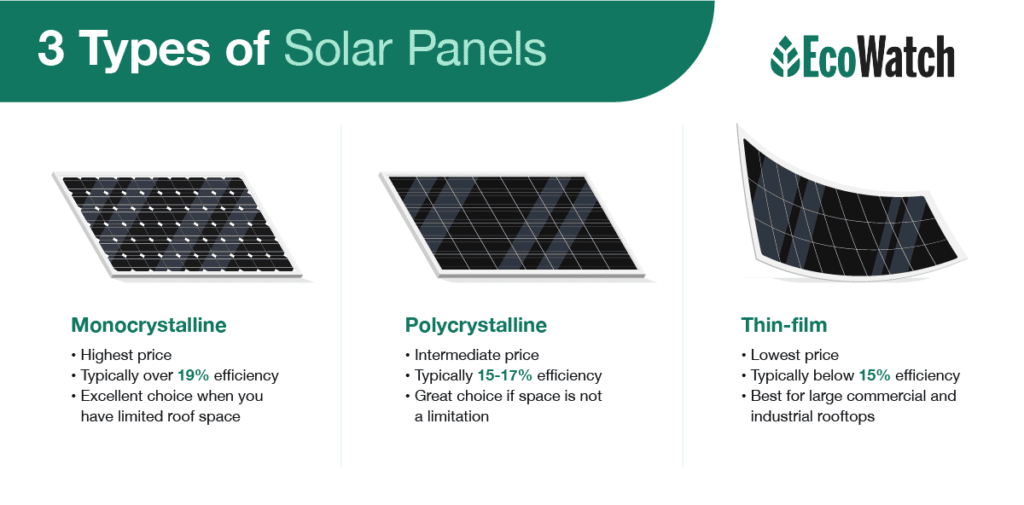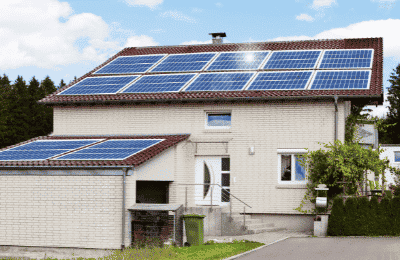
Top 7 Best Solar Companies in Arizona (2024 Reviews)
In this guide to Arizona’s best solar companies, we’ll answer your questions including:
- What are the best solar installation companies in Arizona?
- How do you save money on solar power in Arizona?
- What should you look for in a solar company in Arizona?
Each product and or company featured here has been independently selected by the writer. You can learn more about our review methodology here. If you make a purchase using the links included, we may earn commission.
Arizona is one of the best states in the country to go solar, with the average homeowner saving over $34,982 on their energy bills – after their system pays for itself. Since the demand for solar panels is so high, there are over 170 solar panel companies working in Arizona for you to choose from.
That makes your decision on a solar company all the more challenging – but we’re here to help. In this guide, we’ll be discussing the best solar companies in Arizona, why we’ve chosen each of them and why we think they’re a good candidate for handling your solar project.
What Are the Best Solar Companies in Arizona?
After researching and reviewing dozens of Arizona solar companies, the seven installers below are the ones we believe are the best in the area:
- SunPower: Best National Provider
- ADT Solar: Best Warranty Coverage
- Tesla Solar: Best Technology
- Elevation Solar: Best Regional Installer
- Solar Optimum: Best Customer Service
- Sun Valley Solar Solutions: Best Local Installer
- Verde Solar Power: Most Budget Friendly
Compare Arizona’s Top-Rated Solar Providers
We’ve assessed these companies and countless others based on many different criteria to make sure we bring you the most useful and up-to-date information possible.
Overall, we suggest SunPower or ADT Solar, but all of these providers have something special to offer that sets them apart from the competition. The table below includes a quick side-by-side look at these providers and how they compare in terms of average cost, warranty coverage and more.
| Solar Providers | Superlative | Our Score | Avg Cost ($–$$$$$) | Warranty | Financing Options | Get Quote |
| SunPower | Best National Provider | 5/5 | $$$$ | Minimum of 25 years for equipment, workmanship and production | Get Quote | |
| ADT Solar | Best Warranty Coverage | 4/5 | $$$ | 25 years for equipment, workmanship and production | Cash or solar loan | |
| Tesla | Best Technology | 4.5/5 | $$ | 25 years for equipment and performance; 10 years for workmanship | Cash, solar loan, solar lease, PPA | Get Quote |
| Elevation Solar | Best Customer Service | 4/5 | $$ | 25 years for equipment and performance; 30 years for workmanship | Cash or solar loan | Get Quote |
| Solar Optimum | Best Customer Service | 4/5 | $$$$$ | 25 years for equipment, production and workmanship | Cash, solar loan, solar lease, PPA | Get Quote |
| Sun Valley Solar Solutions | Best Local Installer | 4.5/5 | $$ | 25 years for equipment and production; 10 years for workmanship | Cash, solar loan or lease | Get Quote |
| Verde Solar Power | Most Budget Friendly | 4.5/5 | $$ | 25 years for equipment and production; 10 years for workmanship | Cash or solar loan | Get Quote |

SunPower
Pros
- Most efficient panels on the market
- National coverage
- Cradle to Cradle sustainability certification
- Great warranty coverage
Cons
- Expensive
- Customer service varies by local dealer

Tesla Energy
Pros
- Price-match guarantee
- Sleek, efficient and durable solar panels
- Best solar battery on the market
Cons
- Some reported issues with customer service
- Customer service varies by local dealer
Tesla provides some of the most impressive technology available. Its panels have outstanding performance specifications and above-average efficiency ratings and work seamlessly with other Tesla products.
Tesla runs into some issues with customer service because it outsources its installations, but overall, we think it provides outstanding value for the money.
Why We Chose Tesla for the Best Technology
As one of the largest tech companies in the country, it should come as no surprise that Tesla puts out some pretty impressive technology. That includes its panels, which have efficiency ratings, temperature coefficients and efficiency degradation rates that are all better than average. It also manufactures the Powerwall, which is one of the best solar batteries on the market, especially for the money.
Tesla is one of the few installers that offer price matching, which means its average price is below average. Not only does the overall affordability make Tesla accessible, but the company also accepts cash purchases, loans, leases and PPAs to keep solar available to virtually all Arizona customers, despite above-average local installation costs.
Tesla also offers its solar roof shingles, which most manufacturers don’t produce. These are popular among Arizona homeowners who want to take advantage of solar energy but don’t like the look of panels on their roofs.
What We Don’t Like
The biggest downside to working with Tesla, in our opinion, is the potential for poor customer service. Tesla handles the manufacturing of all of its products, but it outsources panel installation to third parties. Those companies don’t go through a terribly rigorous vetting program, so some don’t offer the best service and can lead to delays in the process.
Tesla also only installs its own products, so there’s no variety, and you’ll be locked into a single brand rather than having your choice of a brand that meets your energy needs or budgetary constraints.
Read our full review of Tesla for more information.
Solar Products
As mentioned above, Tesla only installs Tesla-branded panels. These have better performance specs than most other brands, but this is a downside since you can’t optimize your system to suit your specific needs.
Tesla panels have above-average efficiency ratings that can help you take advantage of the abundant sunlight in your area. Most importantly, they have a below-average temperature coefficient, which means they’ll lose less efficiency in the hot Arizona climate than most other brands.
In addition to panels, Tesla also offers the following products:
- Tesla solar roof shingles
- Tesla Powerwalls
- Tesla EV chargers
- The Tesla app, which lets you monitor your home energy usage, your solar energy production, your solar storage and your EV charging all from one place
Financing Options
Tesla not only has below-average pricing and price matching, but it also keeps renewable energy accessible by accepting all four solar payment options.
As is the case with other installers, we strongly suggest a cash purchase for the highest long-term savings. If you can’t afford to pay for your system upfront — which is likely, given the high installation costs in Arizona — then we suggest a loan.
Leases and PPAs have lower returns on investment (ROI) and don’t let you take the ITC, an average value of around $9,000 in Arizona.
Warranty Information
Tesla’s panels come with three separate warranties, all of which are right in line with the industry averages. The equipment itself is covered for 25 years, the panel performance is guaranteed for 20 years and the labor is covered for ten years.
While this coverage is average, it’s not nearly as robust as what you’d find from companies like SunPower or ADT Solar, so it pales in comparison to the top-rated national providers. Generally speaking, though, your Tesla panels should last for around 25 years.
Facts and Figures: Tesla Energy
| EcoWatch Rating |
|---|
| Better Business Bureau (BBB) Rating |
| Average Cost ($-$$$$$) |
| Solar Services |
| 4.5 |
| C |
| $$ |
| Solar Panels, Solar Batteries, EV Chargers, Solar Roof Shingles, System Monitoring |

Elevation

Average cost
Pros
- Comprehensive service offerings
- Outstanding customer service
- Full-service home energy solutions
Cons
- Limited service area
- Quality of installation may vary by location
Elevation Solar offers a more hands-on approach, and its representatives understand the local needs of Arizona customers and can help you file for local incentive programs to save money.
Elevation Solar doesn’t have as much experience as many other providers in the area, but we still feel it’s a reliable installer.
Why We Chose Elevation Solar as the Best Regional Provider
Elevation Solar services five states and is headquartered in Chandler, AZ. With nearly a decade of localized experience in the Valley and Tucson areas, Elevation’s representatives are able to provide a more customized and localized approach to solar in the Grand Canyon State.
It’s known for great customer service, and its representatives are willing and able to assist you in taking advantage of all of the solar incentives Arizona has to offer. Ultimately, that could mean additional savings you might not get with other providers.
The company has high ratings on Google Reviews and with the Better Business Bureau (BBB), which also speaks to the company’s commitment to customer service.
We’re also pleased to note that Elevation provides quite a few efficiency upgrades and home improvements in addition to installing solar equipment. This is great news for Arizonans, who are often concerned with energy efficiency, given the extreme climate in the area.
What We Don’t Like
Elevation has under a decade of experience. While this might be enough to be familiar with local incentive programs, it also means it has less experience than many competitors that have been around long enough to garner a solid and long-lasting reputation.
Elevation Solar also only accepts cash purchases and loans, which means anyone who can’t afford an upfront purchase or qualify for a loan won’t be able to go solar with this provider. With Arizona’s large system size requirements and high total conversion costs, this can alienate a good portion of the population looking to go solar.
Solar Products
Elevation Solar installs panels from Tesla and REC. These are both great options for Arizonans, as they have above-average efficiency ratings to take full advantage of the abundant sunlight.
The REC panels will generate more power to offset your above-average energy bills, but the Tesla panels are a little more affordable and will likely keep upfront costs down. We would recommend REC panels for the efficiency and superior warranty unless you have a tight budget.
We’ll list the other products and services Elevation Solar offers below, which you can use to improve your home’s energy efficiency or customize your solar array:
- Tesla Powerwalls
- Generac PWRCells
- Smart home energy solutions, like Energy Star products and smart thermostats
- Energy efficiency home improvements, including air sealing and insulation replacement
Financing Options
Unfortunately, Elevation Solar only accepts cash purchases and solar loans, which means you’re out of luck if you’re looking for a lease or PPA.
In an area like Arizona, where the average installation cost is around $7,000 higher than the national average due to the required system size, we really love to see lower-cost and instant-savings options like leases and PPAs for accessibility.
Still, we do recommend cash purchases and loans over any other option.
Warranty Information
Elevation Solar provides outstanding warranty coverage to keep your system and your home protected from damage.
The coverage includes a 25-year warranty for the equipment and the panel performance. The equipment warranty is average, but the performance warranty is five years longer than most other companies offer.
You also get a 30-year workmanship warranty, which is outstanding and three times longer than most companies offer. This isn’t terribly valuable in Arizona, where rainfall and the risk of roof leaks from poor installation is minimal, but it’s still nice to have for the peace of mind.
Facts and Figures: Elevation
| EcoWatch Rating |
|---|
| Better Business Bureau (BBB) Rating |
| Year Founded |
| Average Cost ($-$$$$$) |
| Solar Services |
| Brands of Solar Equipment Offered |
| Warranty Coverage |
| 4 |
| A+ |
| 2014 |
| $$$ |
| Solar Panels, Solar Batteries, Energy-Efficiency Upgrades, Smart Home Energy Solutions |
| REC, Tesla, SolarEdge |
| 25-year manufacturer warranty |

Solar Optimum

Regional Service
Average cost
Pros
- Outstanding customer service
- Comprehensive service offerings
- Great warranty coverage
Cons
- Limited brands of solar equipment available
- No leases or PPAs
- Can be expensive
Solar Optimum provides outstanding customer service and customer care. We’d strongly recommend considering Solar Optimum if you’re looking for industry-leading service and communication throughout the installation process.
Solar Optimum is quite expensive, but we feel it’s worth the investment for the service alone.
Why We Chose Solar Optimum as the Best for Customer Service
Solar Optimum is a regional company, but it’s still small enough to provide hands-on services, fast communication, rapid responses to warranty claims and unmatched customer service overall. If you’re looking for a company that will provide a small-town feel with the resources of a larger national provider, we think Solar Optimum might be the ideal installer for your solar project.
In addition to industry-leading customer service, Solar Optimum also offers excellent warranty coverage that meets or exceeds what you’d find from most other installers. The panel performance warranty, in particular, is helpful for making sure your panels continue to produce power to offset your above-average energy bills and continue to meet your energy demands.
Solar Optimum also accepts all financing options, so it’s going to be more accessible than companies like ADT Solar and Elevation Solar that don’t accept leases and power purchase agreements.
What We Don’t Like
In our opinion, the most significant downside of working with Solar Optimum is the price. It’s about the most expensive installer you can choose in Arizona, and while you get outstanding customer service for the money, it might not be worth the extra money to you.
Above-average installation costs are especially problematic in areas like Arizona, where larger and more costly systems are necessary to offset the high energy needs. Not only will your installation costs be higher than in most other states, but they’ll also be comparatively high within the state if you choose Solar Optimum.
Solar Products
Solar Optimum installs panels from Panasonic and Tesla, both of which are high-efficiency options that should produce plenty of power to offset the above-average electric bills in Arizona.
Of these two options, we’d recommend Panasonic if you’re looking for maximum energy production and Tesla if you’re looking to keep installation costs low. Panasonic panels have a peak efficiency rating of 22.2%, which is above what most other manufacturers offer. Tesla, on the other hand, has a lower cost per watt installed, so it’s better for budget-conscious Arizonans.
In addition to these two panel brands, Solar Optimum offers the following products and services, which are more plentiful than most other companies:
- Tesla Powerwalls
- Enphase IQ solar batteries
- Tesla and Enphase solar monitoring apps
- Roofing, which most installers don’t offer
Financing Options
Solar Optimum is above average in price, but it does aim to keep its products and services accessible by accepting all four payment options. We recommend choosing a cash purchase or solar loan if you can afford them and/or qualify, but the leases and PPAs are great $0-down options that most Arizona residents will be able to qualify for.
Warranty Information
Solar Optimum offers a comprehensive 25-year warranty package that covers panel damage, issues arising from poor installation technique and the panel performance. We love to see installers providing such robust coverage to customers, especially in areas like Arizona, where the investment into a solar array is quite a bit above the national average.
The equipment warranty is in line with the industry average, but the efficiency warranty is five years longer than most, and the workmanship warranty is 15 years longer than most.
Facts and Figures: Solar Optimum
| EcoWatch Rating |
|---|
| Better Business Bureau (BBB) Rating |
| Average Cost ($-$$$$$) |
| Solar Services |
| 4 |
| A+ |
| $$$$$ |
| Solar Panels, Solar Batteries, Solar Roof Shingles, EV Chargers |

Sun Valley Solar Solutions

Local Service
Average cost
Pros
- Offers products from leading manufacturers
- Competitive pricing
- Many financing options
- Multitude of products and services
Cons
- Relatively short workmanship warranty
Sun Valley Solar Solutions only operates in Arizona, so you’ll get the expertise of an installer that understands local power needs and can help you navigate state incentives and rebate programs.
This installer doesn’t have the best workmanship warranty and doesn’t accept PPAs, but we still think it’s an outstanding option.
Why We Chose Sun Valley Solar Solutions as the Best Local Installer
Sun Valley Solar Solutions is based right in Chandler, Arizona, and it has been servicing the surrounding areas, including Phoenix and Tucson, since 2006. Its representatives solely work with customers and systems in Arizona, which means they have experience with meeting the high local electricity demands and helping customers navigate local incentives and rebate programs.
The representatives at Sun Valley not only provide outstanding customer service throughout the installation process, but they’re also communicative and helpful afterward. If you have issues with your system or production or you need help filing for tax incentives and credits, you can bet that the reps will be there for you.
To match its localized customer service, Sun Valley Solar Solutions provides warranty coverage that’s in line with the industry averages. In fact, the power production coverage — which we believe is the most valuable in AZ — is slightly longer than what you’d expect from most other installers.
What We Don’t Like
While Sun Valley’s warranty coverage is in line with the industry averages, we’d love to see a better workmanship warranty, as it only lasts for ten years. This isn’t a huge deal since the risk of roof leaks in Arizona is low because of the minimal annual rainfall, but it is a minor downside.
As a small, local company, Sun Valley Solar Solutions also has a limited service area. If you don’t live in Phoenix, Tucson or the immediately surrounding areas, there’s a good chance this company won’t be able to service your home.
Finally, Sun Valley doesn’t accept PPAs, which limits accessibility a bit.
Solar Products
Sun Valley Solar Solutions provides access to quite a few panel brands, including SunPower/Maxeon, QCells and Tesla, three of the best solar panel brands available.
We strongly recommend the SunPower panels. Although they’re the most expensive, they also have the best performance specifications and are the most likely to meet and exceed your energy demands and save you money over time. If you’re looking for upfront savings, we’d recommend the more affordable QCells panels.
Sun Valley Solar Solutions also provides the following products and services:
- Tesla Powerwalls
- Generac PWRCell batteries
- Tesla solar monitoring app
- Commercial solar, including large solar carports and industrial solar projects.
- Solar panel service, removal and reinstallation services.
- EV charging station installations or electric hookup services for plug-and-play EV chargers.
- Roof replacement
Financing Options
Sun Valley Solar Solutions accepts cash purchases, loans and leases. Cash will provide the greatest savings over time, leases are the most accessible and solar loans offer a good balance between accessibility and long-term benefits.
Sun Valley doesn’t accept PPAs. We don’t recommend these anyway, as leases are nearly just as accessible and offer more savings over time, but it would be nice to have the option.
Warranty Information
Sun Valley Solar Solutions provides the average 25-year coverage for the equipment it installs and a slightly above-average 25-year warranty for the panel production, which is great to have in an area with high energy demands, like Arizona.
The workmanship warranty lasts for just 10 years. This is average, but it’s not nearly as impressive as the coverage you’d get from some other providers in the area.
Click here for a free quote from Sun Valley Solar Solutions.
Facts and Figures: Sun Valley Solar Solutions
| EcoWatch Rating |
|---|
| Better Business Bureau (BBB) Rating |
| Average Cost ($-$$$$$) |
| Solar Services |
| 4.5 |
| A+ |
| $$ |
| Solar Panels, Solar Batteries, Solar Roof Shingles, EV Chargers, Electrical Work, Maintenance & Repairs |

Verde Solar Power

Local Service
Average cost
Pros
- Multitude of products and services
- Outstanding customer service
- Representatives are experts on local policies
- Competitive pricing
Cons
- Doesn't offer products from some popular brands
- No leases or PPAs
Verde Solar Power provides outstanding customer service and high-quality products, all at prices that help combat the naturally high installation costs in your area.
The workmanship warranty isn’t ideal, and the company doesn’t accept PPAs, but it’s still an affordable company that delivers excellent customer care.
Why We Chose Verde Solar Power as the Most Budget Friendly
Most importantly, Verde Solar Power has below-average pricing. Affordability is important no matter where you live, but it’s especially crucial in areas where installation costs are unusually high, like Arizona.
Residents in the Grand Canyon State use more electricity than most Americans per month, which means they need larger and costlier systems to offset consumption. The average system in Arizona costs around $30,000 before incentives, compared to the $23,000 to $24,000 most U.S. residents spend. Verde’s relatively low per-watt prices help maintain more accessible conversion costs.
Verde Solar Power is also a small, local installer based in Cornville, AZ. Much like Sun Valley Solar Solutions, it offers excellent customer service and localized experience. Its techs and salespeople regularly help solar customers save more by taking advantage of solar incentives and rebate programs that larger companies may not have the resources to apply for.
What We Don’t Like
Verde Solar Power doesn’t accept leases or power purchase agreements, so while its low prices help make its systems and services more affordable than most installers, some customers still won’t be able to afford clean energy through this provider.
Additionally, Verde Solar Power only offers a 10-year workmanship warranty. This is in line with the industry average, but we’d still prefer to see an above-average warranty, especially since Arizonans pay more than most for solar panel systems and typically like to see robust coverage for their investment.
Finally, Verde Solar Power only offers one panel brand: SolarEdge. We usually prefer options so customers can choose what suits them best.
Solar Products
As mentioned above, Verde Solar Power only installs SolarEdge panels. These panels interface nicely with inverters to boost efficiency and overall performance, and they max out at an above-average 21.25% efficiency. However, they will lose more efficiency in Arizona’s hot climate, as they have a higher temperature coefficient (0.34%) than many other tier-one options.
Verde Solar Power also installs some other products, which we’ll list below:
- SMA inverters, which can route power from your panels to your home even in the event of a blackout, regardless of whether you have a battery installed.
- Solar batteries; the only options are small, mobile batteries that won’t be sufficient for powering your home but could be used for smaller applications.
- Solar water pumps.
Financing Options
Verde Solar Power accepts cash purchases and solar loans, which limits your payment options. Cash purchases are ideal in terms of savings over time, but they come with unrealistically high costs for many homeowners. Loans are a more affordable option, but they require that you have at least decent credit.
Leases and PPAs are more accessible but aren’t offered by Verde.
Warranty Information
Verde Solar Power includes a 25-year warranty for the equipment and the panel performance, which is excellent. The equipment warranty is average, but the production guarantee is slightly longer than average.
The company also offers a 10-year workmanship warranty. This is also average in the solar industry, but we generally prefer companies that have above-average coverage for the labor, as it instills more confidence in the work and provides more peace of mind for customers.
Facts and Figures: Verde Solar Power
| EcoWatch Rating |
|---|
| Better Business Bureau (BBB) Rating |
| Average Cost ($-$$$$$) |
| Solar Services |
| 4.5 |
| Not Rated |
| $$ |
| Solar Panels, Solar Batteries, System Monitoring, Off-Grid Solar Solutions |
Watch Below: Does This AZ Homeowner’s Cost Savings Make Solar Worth It?
How to Save Money When Hiring a Solar Company in Arizona
With a cost of about $2.61 per watt, the price of solar panels in Arizona is a little below the average cost to install solar panels in the U.S. After the federal solar tax credit has been applied, homeowners can expect to pay between $9,135 and $18,270 for a 5 kilowatt (kW) to 10 kW solar panel system.
This price may induce some sticker shock — many homeowners are caught off-guard by the total price. The good news is that there are plenty of ways to make your total clean energy project more affordable. Let’s explore those below.
Arizona Solar Incentives, Rebates and Tax Credits
The total cost of solar installation is impacted by the energy needs of your home. What do you pay monthly for your electric bill? Your roof configuration, equipment needed and the complexity of the solar installation are just a few factors to consider when you compare free quotes from solar companies.
Look for variation in solar financing. Does the solar company offer solar loans, solar leases or power purchase agreements (PPAs)? Should you pay in full? Here are a few solar incentives and tax exemptions in Arizona that you should be aware of:
| Solar Incentive | Description |
| Arizona Residential Solar Energy Tax Credit | A state solar tax credit of 25% is available for residential solar systems in Arizona (maximum $1,000 personal income tax reduction). |
| Energy Equipment Property Tax Exemption | Arizona offers a property tax exemption on the added property value from solar. |
| Solar Equipment Sales Tax Exemption | Similar to the property tax exemption, Arizona allows an exemption on the state’s 5.6% sales tax. |
| Federal Solar Tax Credit | The federal solar tax credit of 30% is available for solar energy systems purchased before December 31, 2032. The tax credit is set to decrease to 26% in 2033 and 22% in 2034. It will be phased out entirely by 2035 unless it is renewed. |
Controversial policy in the state has all but phased out net metering solar incentives. However, it is still available in certain areas, so we encourage you to check with your local utility company to learn more. It’s also a great opportunity to ask about the impact of net metering on your electricity bill.
Type of Solar Panel
The solar panel type that you choose to install has a large impact on the total cost of your solar system. The more efficient a solar panel is, the more pricey it will be. Regions that experience fewer sunny days require more efficient solar panels that perform better in low-light conditions. Luckily for Arizona, this is not a problem.
Because Arizona gets so much sunshine, homeowners can often get away with more affordable solar panels. This choice can save you thousands of dollars, yet you’ll still benefit from renewable energy and lower energy bills.
System Size
Don’t pay for a solar panel system that’s too big for your needs.
Unlike other states, Arizona does not have net metering available for all its citizens, so excess energy does not freely come back to you as a credit. Instead, take time to review at least one year — if not more — of your monthly energy usage and choose a solar system that will offset your energy costs and not overproduce.
Read Also: Calculate How Much You Can Save By Going Solar
Will Solar Increase Your Home Value in Arizona?
You are guaranteed to see an increase in your property value by installing solar panels. Solar projects may be expensive, but given that the average value increase of an Arizona home sits around $17,030, it is absolutely worth it to install solar in Arizona.3
Homes with solar typically increase in value by about 4.1%, so the amount that your home value increases depends on its current value.4 Even so, the return on your investment (ROI) is excellent in Arizona.
Should Arizona Residents Hire a Professional Solar Installer or DIY?
There is no denying that solar panel installation is expensive, but there are reasons why homeowners should leave the electrical work to professionals. The money you’d save if you install your own panels may seem worth it now, but should something happen to your panels down the line, you’ll probably wish you’d gone with a solar installer.
Electrical and General Safety
Unless you have extensive electrical or solar installation experience, it is not safe to install your own panels. Even the smallest mistake could lead to more extensive damage and fire hazards, which you do not want to risk for your home and family.
When you hire a professional to install your panels, you can guarantee the panels have been installed correctly according to your area’s building codes and protocols.
Solar Panel Workmanship Warranty
Many solar panel installers offer a separate workmanship warranty that covers any problems with installation. When you install your solar panels yourself, you’ll miss out on this opportunity, which could also save you money in the long run.
If you install your panels yourself, you may get the product warranty and performance guarantee, but even these warranties can be at risk. If you install your panels incorrectly, the manufacturer can claim that poor installation was the reason for the malfunction and may not honor your warranty.
Quality Installation
Quality installation is every bit as important as the quality of the panels themselves. Novice or DIY solar installers may not have the experience, tools nor knowledge necessary to install panels correctly. Poor installation can impact the efficiency of your panels, which in turn can impact the amount of energy your panels produce.
What Should Arizona Residents Look For in a Solar Installer?
Every Arizona homeowner has unique needs for their solar system, but there are some industry standards that you should look for as you research different solar companies. To start, our solar experts recommend you review the following:
- Warranty
- Year founded
- Services offered
- Brands of solar equipment offered
- Industry affiliations
- Size of company
- Solar pricing and financing
Warranty
Most solar panel companies in Arizona include a warranty on their products and services, with 25-year warranties being the industry standard of excellence. These high-quality warranties can give some much-needed peace of mind that both the technology and workmanship behind your new solar photovoltaic (PV) system will hold up over the years.
Two types of warranties typically back solar panel installation:
- Equipment warranties guarantee 10 to 12 years of efficiency.
- Performance warranties guarantee 90% production for 10 years, then 80% production at 25 years.
The best companies will offer both equipment and performance warranties for 25 years, but not all companies meet this standard. It’s hard to compete with the comprehensive warranties offered by ADT, but every company on our list — except Sun Valley Solar Solutions — does offer a 25-year warranty of some kind.
Year Founded
The year a business was founded speaks to both its reputation and its experience in the solar industry. The popularity of going solar may mean a surge of “fly by night” solar companies that are inexperienced in solar energy system installation. Although these companies can offer a competitive price, your warranty may not be honored should that company go out of business.
Just because a company is older doesn’t mean it’s the best in Arizona, but that company’s experience can speak for itself simply due to the number of solar systems it has installed. Older companies, such as SunPower and Verde Solar, have coveted solar installation experience that you can trust.
Services Offered
Different solar installers will offer slightly different services. Design and installation of solar panels — such as the advanced design studio offered by SunPower — is one thing, but will the company also help install battery storage and an EV charging station for your electric car? Will it provide windows or weatherization to help boost your household’s energy efficiency?
Choose a full-service solar company like ADT Solar whenever possible, unless you can pinpoint your specific needs. Talk with your electric company to further assess your home’s energy needs. You may be surprised to learn that many solar companies, such as Verde Solar, also offer off-grid and electrical services.
Before you hire an Arizona solar company, it’s helpful to ask about the installation process. Though it may seem simple, the process can vary from company to company.
Brands of Solar Equipment Offered
Different solar equipment brands vary in both pros and cons. Looking for the most affordable solar panels or the most efficient solar panels? Ask the representatives from each company and see what each can offer.
If you’re looking for a specific brand, it’s best to first look at a solar company’s product listings. What brands do they offer? Not all companies offer the Tesla Powerwall battery like Sun Valley Solar Solutions, and many companies — like SunPower — only offer their own solar products.
Reputable solar companies will always ask about your needs first and will not try to upsell you. Get a quote from different solar providers in Arizona to see if there’s a trend in recommendations — you can always price check to see which can offer the best deal.
Industry Affiliations
To ensure the solar provider you hire is reputable and reliable, we recommend hiring a company that’s held in high regard within the industry. Specifically, look for a provider with Solar Energy Industries Association (SEIA) affiliation and North American Board of Certified Energy Practitioners (NABCEP) certification, like the certifications boasted by Sun Valley Solar Solutions.
Size of Company
The size of the solar installation company you choose is as important as the products and services it offers.
We often hear consumers complain that larger companies rely on third-party contractors to install and service their solar energy systems. However, some larger solar companies have an excellent record of service, from installation to system updates and repairs. Always read customer reviews from various sources.
It’s more likely that smaller companies are aware of local renewable energy policies and the nuances in design your system might need. In Arizona, this is especially important due to issues surrounding the dry heat.
Larger companies, however, may find it hard to interpret area-based needs. But, they typically have access to bulk purchasing that a smaller company may not. Ultimately, it is up to you to determine what you need from a solar company.
Solar Pricing and Financing
Not every homeowner has the cash to pay for their entire solar panel system upfront, so make sure to look for companies that offer alternative payment options. The best solar companies in Arizona and throughout the U.S., such as SunPower, offer solar loans, solar leasing and PPAs so that customers from all socioeconomic statuses can afford to go solar.
Methodology: How We Reviewed the Best Solar Companies in Arizona
We researched and reviewed countless installers that operate in Arizona to make sure we only recommend the best of the best. We assess solar companies based on six different criteria and weigh them based on how important we believe they are to your experience and service in Arizona, specifically. We’ll explain those criteria below.
- Local reputation and reviews (20%): First, we look at a company’s overall reputation by assessing ratings on Google Reviews, TrustPilot, BBB and more. We also read through customer reviews to get a sense of how satisfied customers are with the company overall and which areas they fall short in, if any. In an area like Arizona, where the high demand for solar is met with hundreds of companies, this is one of the most significant factors we consider.
- Pricing and financing (20%): Arizonans use more electricity every month than most U.S. residents, which means larger-than-average systems are necessary to offset consumption. That also means higher installation costs. We look at pricing and financing options offered to see how affordable and accessible solar is through each installer.
- Services offered (20%): Arizonans are generally more concerned with energy efficiency than most Americans because they need to combat high summer temperatures and above-average energy demands. We rank companies higher if they have a number of services available to customize systems to meet energy demands and efficiency expectations. These services include things like battery and EV charger installation, roofing and other efficiency home improvements.
- Warranty coverage (20%): Solar arrays in Arizona cost close to $7,000 more, on average, than they do in most other states. With a total investment of over $30,000, warranty coverage to protect that investment is crucial. We prioritize companies that have robust production guarantees, in particular, as high efficiency is necessary in Arizona to offset the above-average energy needs.
- Company experience (10%): We also read through customer reviews to see how customers are treated by each provider throughout and beyond the installation process. Companies get ranked higher if they’re professional and knowledgeable, complete a timely installation and respond positively and quickly to warranty claims.
- Brand quality (10%): Finally, we check to see which panel brands a provider installs. Panels with a high efficiency will help offset the above-average energy bills in Arizona, and those with a low temperature coefficient are most likely to maintain their expected production even in the hot summer temperatures in Arizona, which often drastically decrease a panel’s production capabilities.
Read More About Going Solar in Arizona
- Is Solar Worth It in Arizona?
- Arizona Solar Incentives Guide
- Find Cost Savings on Solar Panels in Arizona
- What to Know Before Buying Solar Panels in Arizona
The cost information presented in this article is derived from a comprehensive analysis, incorporating data from multiple industry sources. The average cost per watt per state was calculated based on figures from Consumer Affairs, Energy Sage, and Berkeley Lab’s Electricity Markets & Policy Department. Additionally, monthly energy consumption and the average monthly cost of electricity were sourced from the U.S. Energy Information Administration, ensuring a well-rounded and accurate representation of the information presented.
FAQs: Best Solar Companies in Arizona
Arizona, the sunniest state in the nation, offers unparalleled value when it comes to harnessing the benefits of solar energy systems. The state has a long history of solar reliance, meaning there are a large number of experienced and reputable solar installers to choose from. For example, Arizona Solar Wave & Energy is recognized as one of the best local solar companies in the state, while Sunpro Solar is a larger company that serves 21 states, including Arizona.
An EcoWatch rating means that our writers and editorial staff have researched as many solar companies as possible. The companies we include in our review lists have not raised any red flags. We analyze what services each company offers and how well they compare with industry standards. We look at what consumers are saying in-depth to see if concerns have been resolved to customer satisfaction. Read more about our methodology here.
Yes. Many solar panels function best in cooler climates since they become inefficient in hot weather conditions. Arizona experiences very dry heat, which reaches well over 110-plus degrees in cities like Phoenix, Mesa, Tempe, Tucson and beyond. A local installer can often navigate the heat of the desert southwest better than a larger solar company. So in this case, the solar company and panels you select do matter.
Tip: High temperatures reduce the durability and efficiency of polycrystalline solar panels. Monocrystalline solar panels hold up better in the heat and offer more kilowatt-hours per square foot covered. The only downside is that monocrystalline solar panels are the more expensive option of these two.
EcoWatch recommends comparing and contrasting a free quote from each of the solar companies that you’re interested in vetting. When a solar installer completes an energy audit, you’ll also gain more insight into solar equipment and pricing that best suit your energy needs and your home. The most affordable solar company should also have a variety of financing options, from paying in full to solar loans and leases.
For many, it’s cost, but in the end, it’s also about sustainability. It’s important to vet the experience and reputation of the solar company. Arizona gets plenty of sun, but you need the right panels and energy storage system for your home.
We understand that investing in a solar energy system can be intimidating, but the first step is actually pretty simple. We always recommend speaking with a few of Arizona’s best solar installers to compare solar quotes and proposals. By comparing these quotes, you can get a better idea of what solar might cost you, and whether solar is worth it for your Arizona home or business.
Related articles
Top Installers For Arizona
Comparing authorized solar partners
-
- Most efficient panels on the market
- National coverage
- Cradle to Cradle sustainability certification
- Great warranty coverage
- Expensive
- Customer service varies by local dealer
A+Best National Provider1985SunPower Panels25-year all-inclusive warranty
Having trouble deciding? Click below and use our process to receive multiple quotes instead:

 233k
233k  41k
41k  Subscribe
Subscribe 








